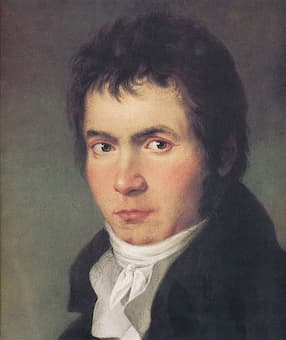
Beethoven, 1803
Beethoven’s Symphony No. 3 “Eroica” premiered on 7 April 1805 at the Theater an der Wien, Vienna. It was immediately recognized as an important work of unprecedented length and complexity. All the movements depart in unexpected ways from his previous symphonic writing. As Beethoven scholars have suggested, “however carefully one studies Beethoven’s evolving style up to 1803, nothing prepares one for the scope, the almost bewildering originality and almost continuous technical certainty manifested in this symphony.”
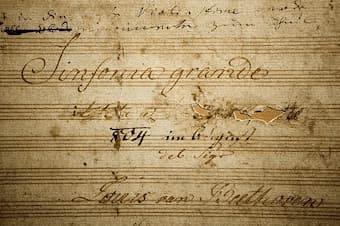
Title Page of Beethoven’s Symphony No. 3 “Eroica”
Beethoven now had the intellectual and technical power to shape his symphonic ideal, and listeners ever since have been able to respond to his heroic quests and spiritual journeys. Without doubt, the “Eroica” is a “watershed work,” one that marks a turning point in the history of modern music. Some of the unusual features can, of course, be explained by reference to the purpose stated in the title of its first publication in 1806, which reads “Heroic Symphony, composed to celebrate the memory of a great man.”
Ludwig van Beethoven: Symphony No. 3, Op. 55 (Eroica) “Allegro con brio”
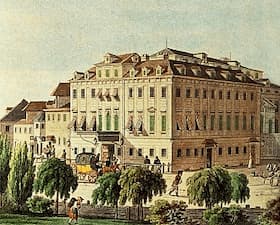
Theater an der Wien
Reviews of the work’s premiere, which was paired with a Symphony in E-flat major by Anton Eberl, were decidedly mixed. “Musical connoisseurs and amateurs were divided into several parties,” a reviewer wrote. “One group, Beethoven’s very special friends, maintains that precisely this symphony is a masterpiece… The other group utterly denies this work any artistic value… through strange modulations and violent transitions… with abundant scratchings in the bass, with three horns and so forth, a true if not desirable originality can indeed be gained without much effort… The third, very small group stands in the middle; they admit that the symphony contains many beautiful qualities, but admit that the context often seems completely disjointed, and that the endless duration… exhausts even connoisseurs, becoming unbearable to the mere amateur. To the public the symphony was too difficult, too long… Beethoven, on the other hand, did not find the applause to be sufficiently outstanding. In fact, Beethoven was seriously irritated that the Eberl symphony received far better reviews.
Ludwig van Beethoven: Symphony No. 3, Op. 55 (Eroica) “Marcia funebre”

Jacques-Louis David: Napoleon Crossing the Alps
A critic immediately confirmed that “this new work of Beethoven has great and daring ideas, and great power in the way it is worked out.” However, it was suggested that “the symphony would improve immeasurably if Beethoven could bring himself to shorten it, and to bring more light, clarity, and unity to the whole.” It seems somewhat surprising that listeners and critics within 10 years of the premiere did not discuss the issues we talk most about today, namely the Symphony’s relation to Beethoven’s life or to Napoleon.
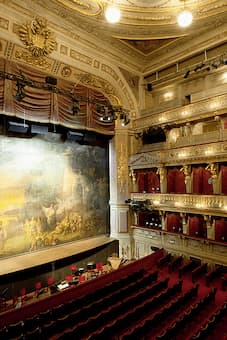
Interior of Theater an der Wien
Ludwig van Beethoven: Symphony No. 3, Op. 55 (Eroica) “Scherzo”
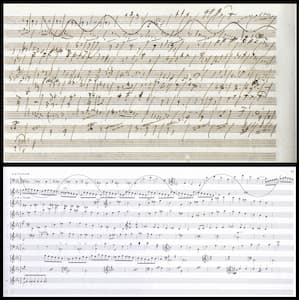
Sketches of Beethoven Eroica Symphony
Some of the most stinging criticism was reserved for the “Finale” movement. Critics felt that this movement did not live up to the promise of the earlier movements at all. An early critic wrote, “the finale has much value, which I am far from denying, however, it cannot very well escape from the charge of great bizarrerie.” It was suggested that Beethoven “wanted only to play games with the audience without taking its enjoyment into account simply in order to unloose a strange mood and, at the same time, to let his originality sparkle thereby.” And to underscore the critical tenor for the entire work, “this finale is long, very long,” a critic wrote. “It is contrived, very contrived; indeed, several of its merits lie somewhat hidden. They presuppose a great deal if they are to be discovered and enjoyed, as they must be, in the very moment of their appearance, and not for the first time on paper afterwards.” In fact, when the symphony was played in London in 1827, the performance “most properly ended with the funeral march, omitting the other parts, which are entirely inconsistent with the avowed design of the composition.” Only gradually did reviewers, scholars and performers come to the conclusion that Beethoven’s Symphony No. 3 “Eroica” is possibly the greatest, most original, and most artistic of all symphonies.
For more of the best in classical music, sign up to our E-Newsletter
Ludwig van Beethoven: Symphony No. 3, Op. 55 (Eroica) “Finale”

I am completely addicted to Beethoven’s music, and that is a pure gem of classical/romantic period. Napoleon just lost one of the most important dedicatory of the whole Music History.